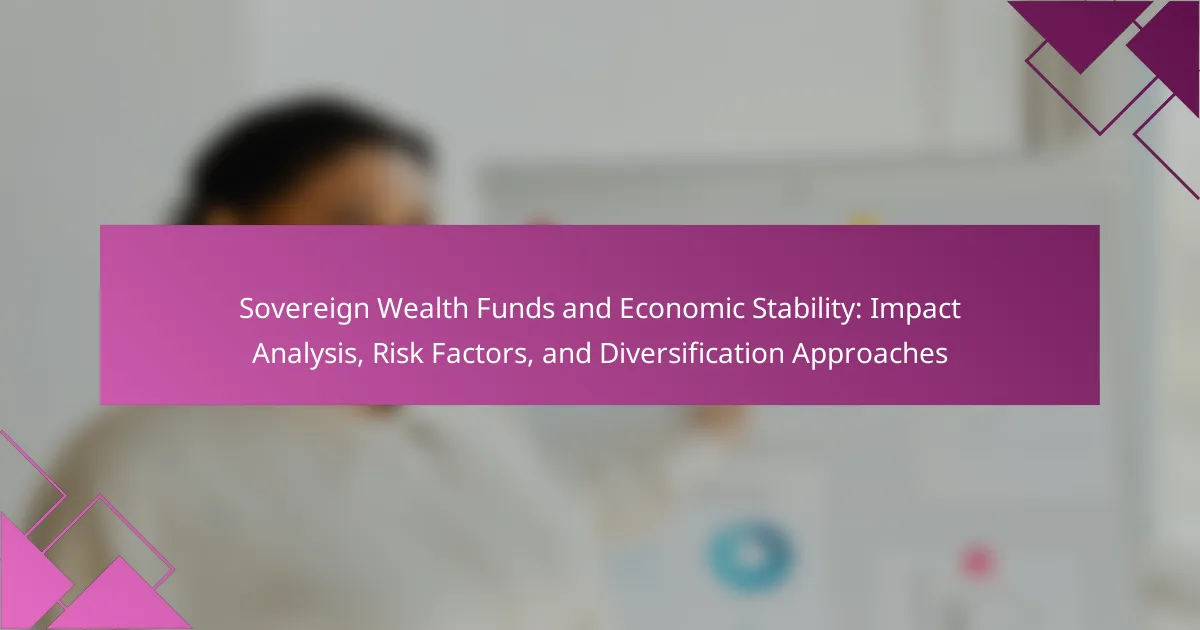
What are Sovereign Wealth Funds and their role in Economic Stability?
Sovereign Wealth Funds (SWFs) are state-owned investment funds or entities. They are used to manage a nation’s reserves, typically derived from surplus revenues. SWFs invest in various assets, including stocks, bonds, real estate, and infrastructure. Their role in economic stability is significant. They provide a buffer against economic shocks and fluctuations. By diversifying investments, SWFs can stabilize national economies during downturns. For instance, during the 2008 financial crisis, many SWFs acted as stabilizing forces. They injected capital into distressed markets, helping to restore confidence. This demonstrates their importance in maintaining economic stability.
How do Sovereign Wealth Funds function within an economy?
Sovereign Wealth Funds (SWFs) function as state-owned investment funds that manage national savings for various purposes. They invest in a diverse range of assets, including stocks, bonds, real estate, and infrastructure. SWFs aim to stabilize the economy by providing a buffer against economic shocks. They can also generate returns to support government budgets and social programs. For instance, the Government Pension Fund of Norway, one of the largest SWFs, invests globally to ensure long-term financial stability. SWFs can influence local economies by investing in domestic projects, creating jobs, and fostering development. Their strategic investments can enhance a country’s global economic standing.
What are the primary sources of funding for Sovereign Wealth Funds?
The primary sources of funding for Sovereign Wealth Funds (SWFs) include government revenues, foreign currency reserves, and state-owned enterprises. Government revenues primarily come from natural resource exports, such as oil and gas. For instance, the Government Pension Fund of Norway is funded largely by oil revenues. Foreign currency reserves are accumulated through trade surpluses and investment income. Additionally, profits from state-owned enterprises contribute significantly to SWF funding. These funds are often reinvested to enhance national wealth and economic stability.
How do Sovereign Wealth Funds invest their assets?
Sovereign Wealth Funds invest their assets through a diversified portfolio strategy. They allocate capital across various asset classes, including equities, fixed income, real estate, and alternative investments. This diversification helps manage risk and achieve long-term financial returns. For example, as of 2022, global sovereign wealth funds held over $10 trillion in assets, with significant investments in both domestic and international markets. They often focus on stable, long-term growth rather than short-term gains. Additionally, some funds invest in infrastructure projects, which can provide steady cash flows. Their investment strategies are influenced by the fund’s objectives, such as economic stability or wealth generation for future generations.
What impact do Sovereign Wealth Funds have on economic stability?
Sovereign Wealth Funds (SWFs) positively impact economic stability by providing a buffer against economic shocks. They invest in diversified assets, which helps stabilize national economies during downturns. SWFs often support infrastructure projects, contributing to job creation and economic growth. For example, the Norway Government Pension Fund Global has helped stabilize the Norwegian economy through its prudent investment strategies. Additionally, SWFs can enhance a country’s credit rating by demonstrating fiscal responsibility. Research shows that countries with SWFs experience lower volatility in economic cycles. Overall, SWFs play a crucial role in promoting long-term economic resilience.
How do Sovereign Wealth Funds contribute to national economic growth?
Sovereign Wealth Funds (SWFs) contribute to national economic growth by investing surplus revenues in diversified assets. These investments generate returns that can be used for public spending. SWFs stabilize national economies during downturns by providing a buffer against fiscal shocks. For example, during the 2008 financial crisis, countries with SWFs could draw on these funds to support their economies. Additionally, SWFs promote sustainable development by funding infrastructure projects. This creates jobs and stimulates local economies. According to the International Monetary Fund, SWFs have significant assets exceeding $10 trillion globally, showcasing their economic influence.
What role do Sovereign Wealth Funds play in stabilizing financial markets?
Sovereign Wealth Funds (SWFs) play a crucial role in stabilizing financial markets by providing liquidity during economic downturns. They invest in various asset classes, including equities, bonds, and real estate, which helps to support market prices. During periods of financial stress, SWFs can act as counter-cyclical investors, buying undervalued assets. This investment behavior helps restore investor confidence and reduces volatility in the markets. For example, during the 2008 financial crisis, many SWFs increased their investments in distressed assets, which contributed to market recovery. Additionally, SWFs often have a long-term investment horizon, which allows them to absorb short-term market fluctuations. Their substantial capital reserves enable them to invest in strategic sectors, further enhancing economic stability.
What are the challenges faced by Sovereign Wealth Funds?
Sovereign Wealth Funds face several challenges. These include market volatility, political risk, and regulatory changes. Market volatility can impact investment returns significantly. Political risk arises from changes in government policies or instability in the investing country. Regulatory changes can affect the operational framework of these funds. Additionally, there is the challenge of achieving diversification while managing liquidity. In 2022, the International Monetary Fund noted that these factors can hinder the effective management of Sovereign Wealth Funds.
What risk factors are associated with Sovereign Wealth Fund investments?
Sovereign Wealth Fund investments are associated with several risk factors. These include market volatility, which can affect asset values. Political risk is another factor, as changes in government policies can impact investments. Currency risk arises from fluctuations in exchange rates, affecting returns on foreign investments. Liquidity risk is present, as some assets may not be easily sold without a loss in value. Operational risk involves potential failures in processes or systems managing the funds. Additionally, regulatory risk may occur due to changes in laws governing investment practices. Lastly, reputational risk can arise from controversial investments, which may affect public perception and support.
How do geopolitical tensions affect Sovereign Wealth Funds?
Geopolitical tensions significantly impact Sovereign Wealth Funds (SWFs). These funds often face increased risk during periods of instability. Political unrest can lead to volatility in financial markets. This volatility affects the asset valuations held by SWFs. Moreover, geopolitical tensions can disrupt global trade. Such disruptions may reduce investment opportunities for SWFs. For example, sanctions imposed on countries can limit their access to foreign investments. Historical events, like the 2014 Crimea crisis, demonstrated how SWFs adjusted their portfolios due to heightened risks. Overall, geopolitical tensions compel SWFs to reassess their strategies and diversify their investments.

How do Sovereign Wealth Funds approach diversification?
Sovereign Wealth Funds (SWFs) approach diversification by allocating assets across various asset classes and geographies. This strategy aims to reduce risk and enhance returns. SWFs typically invest in equities, fixed income, real estate, and alternative investments. They also diversify across different countries and sectors. This global diversification helps mitigate risks associated with economic downturns in specific regions. For example, the Norway Government Pension Fund Global invests in over 9,000 companies across 70 countries. By spreading investments, SWFs can stabilize returns and support national economic stability.
What strategies do Sovereign Wealth Funds use for diversification?
Sovereign Wealth Funds (SWFs) use several strategies for diversification. These strategies include asset allocation across various asset classes. Common asset classes include equities, fixed income, real estate, and alternative investments.
SWFs also diversify geographically by investing in different countries and regions. This helps mitigate risks associated with specific markets. Additionally, they often invest in multiple sectors within industries. This sector diversification reduces exposure to industry-specific downturns.
Furthermore, SWFs may utilize different investment styles, such as active and passive management. This allows them to optimize returns based on market conditions. Many SWFs also collaborate with external fund managers for specialized investment strategies.
These diversification strategies aim to enhance returns while managing risks effectively. For instance, the Norway Government Pension Fund Global, one of the largest SWFs, employs a diversified investment approach across various asset classes and regions. This strategy has helped maintain stability and growth over time.
How do asset allocation strategies impact the performance of Sovereign Wealth Funds?
Asset allocation strategies significantly impact the performance of Sovereign Wealth Funds (SWFs). These strategies determine how funds are distributed across various asset classes. A well-structured allocation can enhance returns and minimize risks. For example, diversification across equities, bonds, real estate, and alternative investments can reduce volatility. Historical data shows that SWFs with diversified portfolios often outperform those concentrated in a single asset class. The Norwegian Government Pension Fund Global, one of the largest SWFs, allocates its assets across multiple sectors to achieve stability and growth. Additionally, strategic asset allocation allows SWFs to align with their long-term investment goals and risk tolerance. This approach is critical for maintaining economic stability and ensuring sustainable returns over time.
What are the benefits of diversifying investments in Sovereign Wealth Funds?
Diversifying investments in Sovereign Wealth Funds (SWFs) enhances risk management and potential returns. It reduces exposure to market volatility by spreading investments across various asset classes. This strategy can lead to more stable long-term growth. Historical data shows that diversified portfolios often outperform concentrated ones. According to a study by the International Monetary Fund, SWFs with diversified investments achieved higher returns over a ten-year period. Additionally, diversification can protect against economic downturns in specific sectors or regions. It also allows SWFs to capitalize on emerging markets and opportunities. Overall, diversification is a critical strategy for maximizing the effectiveness of Sovereign Wealth Funds.
What are the unique attributes of different Sovereign Wealth Funds?
Sovereign Wealth Funds (SWFs) have unique attributes that distinguish them from one another. For example, the Government Pension Fund Global of Norway is known for its ethical investment guidelines. This fund avoids investments in companies involved in certain industries, such as tobacco and weapons. The Abu Dhabi Investment Authority, on the other hand, focuses on long-term investments in infrastructure and real estate. Its strategy aims at generating sustainable returns over decades.
The Singapore Investment Corporation has a unique approach of being highly diversified across asset classes and geographies. This fund actively seeks out opportunities in emerging markets. The China Investment Corporation emphasizes strategic investments that align with national interests. It often invests in sectors like technology and energy.
Each fund’s unique attributes reflect its country’s economic goals and investment philosophies. These differences influence their investment strategies and risk profiles.
How do the objectives of Sovereign Wealth Funds vary by country?
Sovereign Wealth Funds (SWFs) have varying objectives based on the economic and political context of each country. For instance, Norway’s SWF primarily focuses on saving for future generations and stabilizing the economy. In contrast, the United Arab Emirates invests heavily in diversifying its economy away from oil dependency. China’s SWF aims to enhance national economic security and support strategic industries. Countries like Singapore utilize their SWF to generate returns that support national development initiatives. The objectives reflect each country’s unique economic challenges and strategic priorities.
What are some examples of successful Sovereign Wealth Fund diversification?
Norway’s Government Pension Fund Global is a prominent example of successful Sovereign Wealth Fund diversification. It invests in a wide range of asset classes, including equities, bonds, and real estate. As of 2023, the fund’s equity investments represent approximately 70% of its total portfolio.
Singapore’s GIC also exemplifies diversification. It allocates funds across public and private equities, fixed income, and real estate. GIC has a long-term investment horizon, allowing it to explore emerging markets.
Abu Dhabi Investment Authority (ADIA) diversifies through investments in various sectors, including infrastructure and technology. ADIA’s portfolio includes both local and international assets, enhancing its risk-adjusted returns.
These examples demonstrate effective strategies in diversifying Sovereign Wealth Funds, aiming for stability and growth.

What best practices can enhance the effectiveness of Sovereign Wealth Funds?
Best practices to enhance the effectiveness of Sovereign Wealth Funds include establishing clear investment mandates. These mandates should align with national economic goals and risk tolerance. Transparency in operations is crucial for building public trust and accountability. Regular performance evaluations ensure that funds meet their objectives. Diversification across asset classes mitigates risks and enhances returns. Engaging with experienced investment professionals improves decision-making processes. Adopting a long-term investment horizon allows for better capital growth. Following these practices can lead to sustainable economic benefits.
How can transparency and governance improve Sovereign Wealth Fund operations?
Transparency and governance can significantly enhance Sovereign Wealth Fund operations. Transparency fosters accountability and trust among stakeholders. It allows for better monitoring of fund performance and decision-making processes. Improved governance structures ensure that investment strategies align with national interests. Strong governance frameworks can mitigate risks associated with mismanagement or corruption. Studies show that funds with high transparency ratings tend to perform better. For example, the International Monetary Fund emphasizes that transparent practices lead to more sustainable investment outcomes. Enhanced governance also encourages stakeholder engagement and public support. This ultimately contributes to economic stability and growth.
What role does stakeholder engagement play in Sovereign Wealth Fund success?
Stakeholder engagement is crucial for the success of Sovereign Wealth Funds (SWFs). It fosters transparency and builds trust among stakeholders. Engaging stakeholders helps align the fund’s objectives with public interests. This alignment can lead to increased support for investment decisions. Effective communication with stakeholders can mitigate risks associated with political and social challenges. Studies show that SWFs with strong stakeholder engagement perform better in terms of returns and stability. For instance, the International Monetary Fund highlights that transparency and accountability enhance the credibility of SWFs. Overall, stakeholder engagement is integral to ensuring sustainable and responsible fund management.
How can risk management frameworks be strengthened in Sovereign Wealth Funds?
Risk management frameworks in Sovereign Wealth Funds can be strengthened by implementing comprehensive risk assessment models. These models should analyze market volatility, geopolitical risks, and economic conditions. Regular stress testing can identify vulnerabilities in investment strategies. Enhanced data analytics can improve decision-making processes. Establishing clear governance structures ensures accountability and transparency. Training staff on risk management best practices is essential. Collaborating with external experts can provide additional insights. Continuous monitoring and updating of risk policies will adapt to changing environments.
What future trends are likely to impact Sovereign Wealth Funds?
Future trends likely to impact Sovereign Wealth Funds include increased focus on sustainability and ESG criteria. This shift reflects a growing demand for responsible investment practices. Additionally, technological advancements in data analytics will enhance investment strategies. Global economic shifts, such as rising inflation and geopolitical tensions, will also influence decision-making. The diversification of assets into alternative investments is expected to continue. Regulatory changes may affect operational frameworks and investment approaches. These trends are supported by the increasing integration of climate risk into financial assessments. Furthermore, the rise of digital currencies could reshape investment landscapes.
How will technological advancements influence Sovereign Wealth Fund strategies?
Technological advancements will significantly influence Sovereign Wealth Fund strategies by enhancing data analysis capabilities. Improved analytics will allow funds to assess investment opportunities more accurately. Advanced algorithms can identify trends and risks that were previously undetectable. Additionally, automation will streamline operational processes, reducing costs and increasing efficiency. Blockchain technology may enhance transparency in transactions and asset management. Furthermore, artificial intelligence can support decision-making by providing predictive insights. These innovations will enable Sovereign Wealth Funds to adapt to market changes more swiftly. Overall, technology will empower funds to optimize their investment strategies and achieve better returns.
What emerging markets should Sovereign Wealth Funds consider for investment?
Sovereign Wealth Funds should consider investing in India, Vietnam, and Brazil. India is experiencing rapid economic growth with a projected GDP growth rate of 6.5% in 2024. Vietnam has become a manufacturing hub, attracting significant foreign direct investment, with a growth rate of 6.7% forecasted. Brazil offers vast natural resources and a diverse economy, with an expected growth rate of 2.5%. These markets provide opportunities for high returns and diversification. Investing in these emerging markets can enhance portfolio resilience against global economic fluctuations.
What practical tips can enhance the management of Sovereign Wealth Funds?
Establishing clear investment objectives can enhance the management of Sovereign Wealth Funds. These objectives should align with national economic goals. Implementing a robust governance framework is essential. This framework ensures accountability and transparency in decision-making. Diversifying investments across asset classes reduces risk exposure. This strategy helps in mitigating volatility in financial markets. Regular performance evaluation and reporting are crucial. This practice allows for timely adjustments in strategy. Engaging with external advisors can provide valuable insights. Their expertise can enhance investment decisions. Lastly, maintaining a long-term investment horizon fosters stability. This approach aligns with the nature of sovereign wealth funds, which often manage funds for future generations.
Sovereign Wealth Funds (SWFs) are state-owned investment entities that manage national reserves and play a critical role in economic stability by diversifying investments across various asset classes. This article analyzes the impact of SWFs on economic stability, exploring their functions, primary funding sources, and investment strategies. It also addresses the challenges and risk factors associated with SWF investments, while highlighting the importance of diversification and unique attributes of different funds. Furthermore, it examines future trends and practical tips for enhancing the management of SWFs to ensure sustainable economic growth.
